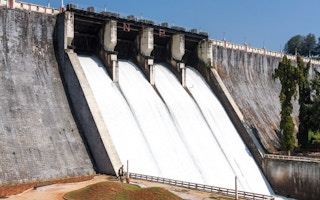The Lower Subansiri hydroelectric power station, India’s largest underconstruction dam with a potential output of 2 gigawatts (GW), was originally due to be operational by 2011 at a cost of US$756 million.
Construction work on the dam, which crosses the Subansiri River on the border of Assam and Arunachal Pradesh in India’s Himalayan region, began in 2005, but stopped due to protests over its environmental impact.
Work resumed in 2019 after clearance was granted by the National Green Tribunal (NGT), a statutory body that deals with environmentally disputes. The restarted project has a new price tag – USD$2.4 billion – nearly three times the original cost.
Since the resumption of work on the dam, landslides and flash floods have repeatedly halted progress, the latest landslide in October 2023 severely affecting water flow through the river.
The 800-megawatt (MW) Parbati II hydroelectric project in the Kullu district of Himachal Pradesh in the Himalayas was originally supposed to be completed by 2010 at the cost of US$471 million. As of January 2024, the dam has still not been built, and the final cost is estimated at US$1.3 billion. Slow progress on the project has been blamed on “geological constraints” and heavy rainfall.
Slow flow
Hydropower has been identified as key to India’s ambition to reduce its reliance on fossil fuels, which still make up well over half of the country’s energy mix, and meet the world’s largest population’s rising demand for energy.
Hydropower currently accounts for a low single-digit percentage of the energy supply, but the world’s third largest greenhouse gas emitter is aiming to boost the share of non-fossil fuel sources to 50 per cent by 2030, with hydro playing an increasing role in India’s decarbonisation plan.
But growth has been slow. A decade ago, India had 39.4 GW of installed capacity from large hydroelectric dams. Today, installed big hydro capacity is just 47 GW, with 18 GW under construction and 21.8 GW approved but, for a variety of reasons, not yet started.
The slow pace of approved and under-construction projects has prompted energy experts to predict that large hydropower could be put on the back burner, at a time when solar and wind energy tariffs are falling.
According to Vibhuti Garg, South Asia director of the Institute for Energy Economics and Financial Analysis (IEEFA), a think tank, large hydro’s share of the energy mix has fallen as capacity has stagnated. Environmental and social concerns surrounding big hydro projects, including the large-scale displacement of local communities, have led to delays and huge cost overruns, she observes.
While the future of large hydro remains uncertain, the government has been heavily promoting the deployment of pumped hydro and storage, which provides a reliable alternative energy source to wind and solar, notes Garg.
The government’s new PSP development policy, released in 2023, pointed out that while wind and solar are now among the cheapest sources of renewable energy, their “intermittent nature” can destablise the grid.
PSP has been identified as a viable solution” to the integration issues posed by solar and wind, as it can store large amounts of energy during off-peak times and discharge over longer periods.
PSP would have minimal environmental impact as it would mainly be deployed on existing dam sites, in reservoirs or off-the-river projects, the government said.
Stranded assets
Opposition to large hydroelectric power projects from people living down stream, as well as budget shortfalls and natural disasters, have slowed dam-building in India to a trickle. The last decade has seen a near-complete withdrawal of the private sector from large hydro projects, and the government has had to step in to keep projects afloat.
In January 2023, work stopped on the 520 MW Tapovan-Vishnugad dam in Uttarakhand following large-scale land subsidence in the nearby town of Joshimath. Local residents and environmentalists blamed the landslide on the construction of the Tapovan-Vishnugad dam, and that of the nearby 444 MW Vishnugad-Pipalkoti dam.
Although the state’s high court allowed work to restart in May, construction of the Tapovan-Vishnugad dam has been slow, while the Vishnugad-Pipalkoti dam has been hobbled by a funding shortfall.
The cost of the Tapovan-Vishnugad dam has risen from a projected US$358 million to US$926 million, while the expected outlay on the Vishnugad-Pipalkoti dam has jumped from US$300 million to US$464 million.
Cost overruns have often led to disputes, with the hydro power purchaser demanding that the tariff be renegotiated, leading to further delays.
The 180 MW Bajoli Holi project in Himachal Pradesh, the 120 MW Rammam dam in the Himalayan state of Sikkim and the 76 MW Phata Byung project in Uttarakhand are among private sector-funded hydro projects to have hit the rocks.
The 400 MW Maheshwar project in Madhya Pradesh has been suspended since 2011 after the developer ran into cash flow problems. The state government terminated the power purchase agreement in 2020 and the developer has since filed for bankruptcy.
“In India, while small hydro was considered renewable, large hydro projects were not until recently due to various environmental considerations. However, given India’s renewable energy requirements to meet its revised Nationally Determined Contributions under the Paris Agreement, there is a need to re-look at hydro – not abandon it,” said Dhruba Purkayastha, India director of Climate Policy Initiative, a US-based analysis and advisory group.
Hydro projects have become stranded assets as a result of poor bid process management, improper risk allocation and inaccurate cost calculations, he said.
“The private sector should not be asked to bear risks beyond their control, such as geological issues and water availability. But that’s exactly what has led to the problem of stranded assets. When projects got hit by issues beyond the companies’ control, the government did not bail them out,” he told Eco-Business.
A senior official from India’s power ministry, who spoke to Eco-Business on condition of anonymity, said that India is looking at large hydro more as projects that secure the energy supply and stabilise the grid than as commerical opportunities.

















